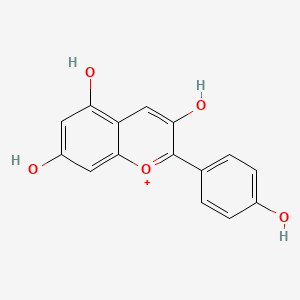| MeSH term | MeSH ID | Detail |
|---|---|---|
| Parkinsonian Disorders | D020734 | 20 associated lipids |
| Cystitis | D003556 | 23 associated lipids |
Pelargonidin
Pelargonidin is a lipid of Polyketides (PK) class. The involved functions are known as Uptake, Intestinal Absorption, glucose uptake, Process and Metabolic Inhibition. Pelargonidin often locates in Serosal, Mucous Membrane, brush border membrane, Membrane and Cell surface. The associated genes with Pelargonidin are SLC5A1 gene, SLC2A2 gene, Homologous Gene, F3 gene and CRSP3 gene. The related experimental models are Knock-out.
Cross Reference
Introduction
To understand associated biological information of Pelargonidin, we collected biological information of abnormalities, associated pathways, cellular/molecular locations, biological functions, related genes/proteins, lipids and common seen animal/experimental models with organized paragraphs from literatures.
What diseases are associated with Pelargonidin?
There are no associated biomedical information in the current reference collection.
Possible diseases from mapped MeSH terms on references
We collected disease MeSH terms mapped to the references associated with Pelargonidin
PubChem Associated disorders and diseases
What pathways are associated with Pelargonidin
There are no associated biomedical information in the current reference collection.
PubChem Biomolecular Interactions and Pathways
Link to PubChem Biomolecular Interactions and PathwaysWhat cellular locations are associated with Pelargonidin?
Visualization in cellular structure
Associated locations are in red color. Not associated locations are in black.
Related references are published most in these journals:
| Location | Cross reference | Weighted score | Related literatures |
|---|
What functions are associated with Pelargonidin?
Related references are published most in these journals:
| Function | Cross reference | Weighted score | Related literatures |
|---|
What lipids are associated with Pelargonidin?
There are no associated biomedical information in the current reference collection.
What genes are associated with Pelargonidin?
Related references are published most in these journals:
| Gene | Cross reference | Weighted score | Related literatures |
|---|
What common seen animal models are associated with Pelargonidin?
Knock-out
Knock-out are used in the study 'MATE2 mediates vacuolar sequestration of flavonoid glycosides and glycoside malonates in Medicago truncatula.' (Zhao J et al., 2011).
Related references are published most in these journals:
| Model | Cross reference | Weighted score | Related literatures |
|---|
NCBI Entrez Crosslinks
All references with Pelargonidin
Download all related citations| Authors | Title | Published | Journal | PubMed Link |
|---|---|---|---|---|
| Sentandreu E et al. | LC-DAD-ESI/MS(n) determination of direct condensation flavanol-anthocyanin adducts in pressure extracted pomegranate (Punica granatum L.) juice. | 2010 | J. Agric. Food Chem. | pmid:20839870 |
| Roghani M et al. | Oral pelargonidin exerts dose-dependent neuroprotection in 6-hydroxydopamine rat model of hemi-parkinsonism. | 2010 | Brain Res. Bull. | pmid:20558255 |
| Estévez L and Mosquera RA | Conformational and substitution effects on the electron distribution in a series of anthocyanidins. | 2009 | J Phys Chem A | pmid:19685919 |
| Jordheim M et al. | Acylated anthocyanins in inflorescence of spider flower (Cleome hassleriana). | 2009 | Phytochemistry | pmid:19427007 |
| Korte G et al. | An examination of anthocyanins' and anthocyanidins' affinity for cannabinoid receptors. | 2009 | J Med Food | pmid:20041802 |
| Ikegami A et al. | Molecular identification of 1-Cys peroxiredoxin and anthocyanidin/flavonol 3-O-galactosyltransferase from proanthocyanidin-rich young fruits of persimmon (Diospyros kaki Thunb.). | 2009 | Planta | pmid:19641937 |
| Zhang Y et al. | The potato R locus codes for dihydroflavonol 4-reductase. | 2009 | Theor. Appl. Genet. | pmid:19588118 |
| Forni C et al. | Role of transglutaminase 2 in quercetin-induced differentiation of B16-F10 murine melanoma cells. | 2009 | Amino Acids | pmid:18688565 |
| Albert NW et al. | Light-induced vegetative anthocyanin pigmentation in Petunia. | 2009 | J. Exp. Bot. | pmid:19380423 |
| Vafeiadou K et al. | The citrus flavanone naringenin inhibits inflammatory signalling in glial cells and protects against neuroinflammatory injury. | 2009 | Arch. Biochem. Biophys. | pmid:19467635 |
